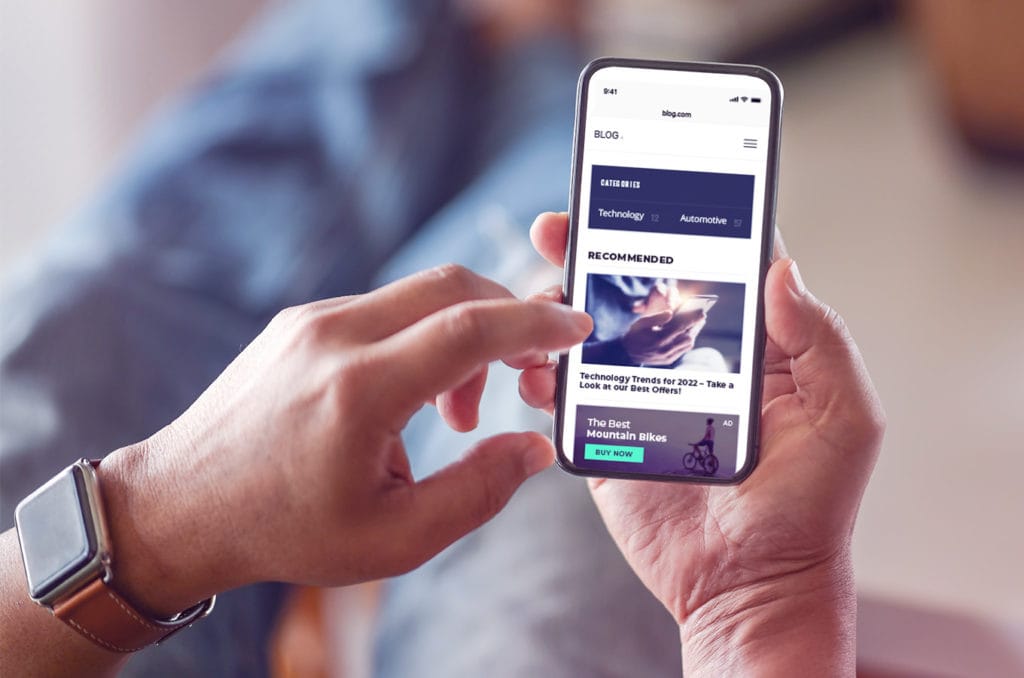What’s cool about being an affiliate is the fact that you can earn by advertising the product or website – even if you’re not the owner of it.
Sounds delusional? Here’s how it works if we take an e-commerce offer as an example:
✅ You get a unique link that the online store generates for you
✅ You promote affiliate links in one or several sources
✅ Maybe perform some optimization
and when a user goes through your link and ends up buying a product…
🥁(drumroll)
…you earn money.
Naturally, there might be thousands of different scenarios, but the simplest explanation for being an affiliate marketer will be: promoting other peoples’ offers to get a commission for the users that you brought to the website and converted. A conversion or action can be anything that the offer owner defined: sign up to the newsletter, registration on the page, purchase.
How do affiliate links work?
The affiliate links – which are sometimes also called referral links – provided by affiliate networks, affiliate program owner or actual product owners differ from one platform to another.
In some networks, the affiliate link that you will get as an advertiser may contain, for example, a tracking domain with some extra parameters like your unique affiliate id, the URL of the promoted page:
https://987abc.com?affiliate_id=123&url=offer.comThere can be also cases where the URL that affiliate links that you get to promote bases on the page URL itself, with only some affiliate id appended:
https://offer.com?affiliate_id=123Instead of that, some platforms can provide you with the URL string that is generated uniquely per affiliate and contains only the tracking domain without any parameters appended:
https://aff123.com/658658343537So as you see, every affiliate link can be a different kettle of the fish depending on the platform that provides it.

Well… maybe not literally, but you get the point.
Regardless of how a specific affiliate link looks, it’s supposed to be generated uniquely per affiliate – as then the platform is able to learn who brought the visitor to the page and associate the conversion (registration, purchase) with the lead’s source (a person that advertises it – you).
So in simple words: such referral links help offer owners count the number of specific affiliate sales and calculate an affiliate revenue.
Where to get an affiliate link from?
You probably think that’s the hardest part, don’t you? Well not at all.
There are so many different products and services out there which make it pretty easy to find an affiliate marketing program.
But if you have a lot of options it is not always so easy to choose one, right? You don’t want to find just one affiliate program to participate in – you want to find THE one.
Even though there are a lot of listings with affiliate programs out there, I’d recommend you to check out this ranking of the best and highest paying ones.
Once you find a program for you and generate an affiliate link, the next question that may pop up in your head will probably be…
There are several ways of promoting affiliate links out there. You can select the one that will be the best fit for you depending on if you’re an influencer with your own audience, an affiliate marketer without your own traffic, or an active forum member.
Let’s take a look at the list below to learn about the top 8 ways to promote affiliate links, and make one of them your own.

1. In your blog post
If you have your own blog you can create an article that includes affiliate links related to a specific area or category of the website that you own.
For example: if you’re a blogger that writes about affiliate marketing, depending on the subject that you’re covering in your specific blog post you can mention, for example, the best affiliate networks from which you can get offers or some affiliate programs.
Did someone mention me?!
Writing that part made me wonder: maybe I should use some affiliate links too in this article 🤔 Well… I won’t – at least not in this one 😅
2. On a product review or comparison page
The other way to promote affiliate links while being a blog owner can be by preparing product reviews or product comparisons.
So when you’re writing about makeup techniques or beauty routines you can add affiliate links in comparison posts. Review pages may be very attractive for readers, as they’re usually looking for products that have already been tested by someone – because who wants to be an experimental rabbit by themself?! 🐇
With the correct approach you can kill two birds with one stone: help readers to make the final purchase decision, and at the same time get a commission, but maybe just… without killing anyone ☠️
You don’t necessarily have to be a blogger – even as an e-commerce shop owner or any type of publisher (news page, i-gaming operator) you can have some space for advertisements on your website. So why not make use of it to earn some commission by promoting affiliate links?

With the current options available online, you don’t have to prepare banners in regular photo editors as you can create them much quicker with tools like Abyssale, Canva, or Visme. These platforms offer templates (and some of them are free!), for creating nice creatives that you can later place on your website and connect the affiliate links with these.
4. In your Social Media posts and stories
But wait. You don’t have to be an e-commerce or owner of any online or physical product to promote affiliate links, right?
So what if you’re an influencer, with your own audience on social media platforms like Facebook, Instagram, and TikTok?
Then you can use your reach to promote affiliate links in your stories, under your social media posts, or in your Instagram bio.

Depending on which option you choose it can be done either for free (if you embed affiliate links in a photo description or your story) or you can consider using social media advertising – setting some paid ads. Speaking of which, let’s smoothly move to another option…
5. In your marketing campaigns
That may sound obvious for all affiliate marketers that feel like a fish in water when it comes to digital marketing, but… you can always generate more visits while promoting affiliate links through paid campaigns. In addition to the traffic generated only by your social media followers.
How?
If you already had a chance to work with the online marketing campaigns before, or better, when you’re introducing yourself as an affiliate, before telling even your name while meeting new people 😂 then you might come across sources like Outbrain, Taboola, PropellerAds, Zeropark, FacebookAds, GoogleAds and more.
These are the places where you can run ads and buy traffic for your own website, other peoples’ websites, or your affiliate links. You can choose from traffic types like: native, pop, push, social media, photo/video, banner ads, and more.
6. Email marketing campaigns
The other option that can help you with advertising your affiliate link is email marketing. That way you can add the URL to the email’s content to convert traffic directly, or you can use email campaigns to generate more traffic to your website or blog – so in addition to one of the previous options I’ve mentioned.
There are various campaign types out there, but email marketing is quite unique and has its own bonuses. You should stick to them, to make sure that you will make some profits.

To successfully run an email campaign it’s extremely important for you to understand the needs of your target group, as well as know the different types of content that you can use in your emails: newsletters, cart abandonment, re-engagement messages, and more.
7. Forums and blog comments
Are you an active forum member or blog reader? If so, you can also take advantage of your recognizability there to promote your affiliate links.
However you have to keep in mind that some of the forums, like for example Quora or Reddit, usually don’t want you to add affiliate links directly in your post’s content, so instead of doing that you can either link to your own blog or redirect to a landing page that has the URL added in the text or under the banner/image.
Using forums might be a good way to generate some extra traffic for your affiliate link, but you have to make sure that your content is unique and interesting enough to attract people more than the competitive ones.
8. Place in video content / podcast notes
Content makers don’t worry, there’s also something for you! If you’re a video channel owner or podcast creator you can place affiliate links in your video/podcast notes or descriptions.
It’s highly possible that if you will promote the products or services through an audio or video format (by honestly saying why you love it and why your audience should check it out) the conversion rate of your affiliate link will be much higher.
So: if you create Youtube videos you can definitely spare some time (but not too much!) to mention the product that you like in your content, and embed affiliate links in the video or notes.

For new podcasters – especially ones that just started gathering an audience – it might be challenging to monetize your podcasts. To do that naturally, but also efficiently, you can search for some resources that may help you learn how to promote affiliate links while being a new podcaster.
Okay, we went through the best ways to promote affiliate links, but…
How to promote affiliate links successfully?
If you expect an easy answer to this question, I’m afraid that I won’t be able to provide you with one, as there is no single recipe for being successful while advertising affiliate links, but…
I have some recommendations for you that might help you make the most of that.
Dos while promoting affiliate links
Be authentic.
Sounds simple, but it’s not always obvious.
When you’re advertising as a blog/website/podcast owner, or an influencer in social media, you have to be authentic and believe in the product that you advertise. Otherwise, the readers and subscribers would not only resign from clicking on your affiliate link and buying anything, but you may also lose their trust in you.

So it’s crucial to focus only on the products and services that you’re actively using and which you like. Then, creating and promoting content will be not only easy but also a natural process.
Be accurate.
There’s no sense to place links in the article that are not related to its content. It is neither interesting for a reader nor converts well.
Actually, it can give the opposite effect from the one intended and make the people that are visiting your page or checking your posts confused.
So if you plan to place the affiliate links on your own page or blog, you should select products that match your content while searching for the affiliate programs.
Try different ways of promoting.
Remember: you don’t have to select only one source of traffic. You can optimize your page for SEO to get more organic visits but you can also create some paid ads.
When it comes to the paid traffic sources where various sources are available, it’s always good to check with the traffic source’s support if they have an audience that may be especially interested in the blog or product that you’re advertising.
You can also test different landing pages if you want to add an additional step between the paid ads/your blog article, and the actual affiliate link.
Even if you don’t know how to code, you can still make a landing page where you’ll add your affiliate links!

This can be done with the use of landing page builders like Unbounce, Instapage, or Leadpages, which allow you to use some predefined templates and elements for easier page creation.
Measure the performance.
You can spend a lot of money on digital marketing campaigns, but if you don’t monitor their performance, you will most likely waste the potential of affiliate products that you promote. You may not get the maximum of it.
So what should you do to measure the performance? Don’t expect me to provide you with another answer (as I’m supporting clients of the best tracking and optimizing platform ;)) you should:
Track.
But how? As this is quite a broad topic, I’ll save you this one at the end. Be patient, I promise: it will be a cherry on the top.
Don’ts while promoting the affiliate links
Don’t pretend that you’re not advertising.
Just don’t do that. You have to be clear about it if some of the articles on your blog are promoted or if you place affiliate links somewhere within your content.
If you don’t do that, but your reader or visitor notices affiliate links across the whole content, it may leave a bad impression, and bring more damage than good.
On your social media or blog posts, as well as in the podcast/videos or their description you should add a clear affiliate disclosure before linking the page.
Don’t promote similar products within one page/article.
When you link multiple products in one article – especially the ones that may compete with each other – they’re basically cannibalizing each other.
It’s better not to include similar products within one article unless you’re making a landing page that behaves as a ranking/comparison page for online products or services, as then readers may learn more about different nuances and functionalities, and make a purchase decision on their own.
Don’t overdo it
Well… sometimes too much is not good – unless you mean the biggest portion of ice cream, when it’s a sunny day and more than 22 celsius🍦

Sorry, but the season just started, don’t blame me.
Readers may feel overwhelmed if the promotion of affiliate links is made in an aggressive way. They may not want to click further when they spot thousands of CTAs (I know you will notice this one! 😶) within one article. You want them to be intrigued by the product that you’re advertising, not scared.
How to track affiliate links and affiliate revenue?
I promised to answer that question, and here I am.
To see which sources fit best for generating convertible traffic for your website (where your affiliate links are placed) or these links directly, you may use a tracking solution that will help you monitor the performance of your paid ads and organic campaigns.
While using such a platform you will be able to see which of your landing pages attracts users the most, based on the CTR% and other metrics.
But there’s one more thing related to monitoring your campaigns’ performance: it’s conversion tracking. A conversion is always an action that the affiliate program owner defines, but it can be for example successfully registering, buying a product, or making a deposit.
Tracking conversions is pretty important, and if the affiliate program in which you’re participating gives you an option to do that, you definitely take the opportunity. Why?
Monitoring how many conversions you get from visitors that came from a specific source or landing page gives you the option to optimize campaigns based on the ROI% and select only the traffic that works best for these.

Postback vs pixel
There are two ways of conversion tracking: S2S postback and conversion pixel/script.
Conversion pixel/script is a cookie-based conversion tracking type – such codes are usually placed directly on the ThankYou page or in Google Tag Manager, so when it comes to tracking conversions from affiliate links, usually postback is more popular.
If only the postback method is supported by the affiliate program that you selected, it’s the best one to use with your tracker, because it’s a cookie-less solution, which means that it will work regardless of the fact that the visitor will clear out the cookies or the browser will block them.
Thankfully more and more platforms and offer owners support postback tracking these days, as it’s one of the most reliable solutions.
All right, so I hope that there’s only one question left after reading the above: where to track affiliate links?
Track ’em all in Voluum!
Does not matter if you’re an affiliate marketer or influencer – when you promote your affiliate links you have to keep in mind that not only the volume of traffic matters but also its quality.
That’s why it’s incredibly important to get a tracker that connects all of the pieces to simplify your optimization process and maximize your earnings.
Sign up to Voluum today and get the most out of promoting your affiliate link!




